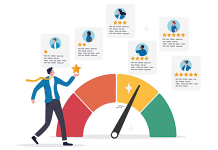Call it the Great Resignation, call it a COVID-era talent shortage, call it what you will: The fact is the hiring market is tougher than we’ve ever seen it. According to the Bureau of Labor Statistics, U.S. employers are currently trying to hire for 11.5 million jobs. Meanwhile, 4.5 million people are quitting their jobs each month, either to leave the workforce or to look for something new.
In other words, if you want to improve or merely retain your team in the current job environment, you’re in stiff competition with countless other employers. Many employees and potential hires have multiple job opportunities to choose from. To attract and retain the best talent, you need to be able to differentiate your opportunity from all the others.
For sellers, a key differentiator is how well they’re set up for success. Sellers want to know that they can meet or exceed quota and that their managers will provide them with the tools and resources they need to do it.
Sales leaders need to show sellers that they are taking these three important steps to help their sellers start hitting their goals as quickly and efficiently as possible:
Give Them the Best Accounts
It all starts with how territories are determined and the data behind those decisions. Nothing frustrates a seller faster than working a list of accounts that have absolutely no intention of buying. Unfortunately, that’s the reality in a lot of organizations that are relying on outdated approaches.
Old-school territory design and account assignments are based on unscientific hunches and best guesses. Sellers might get a list of 500 or more leads to work, based on geography, industry or other general information. Or they might get hand- overs from the marketing department, which argues that because a person downloaded an ebook, they are a hot lead.
We know, however, that these methods of qualification are unreliable. They lead to frustration, wasted time and spinning wheels.
Sales leaders can prevent that by providing their business development reps and AEs with a healthy mix of accounts that are maximized for revenue potential. The goal is that each year, your territory design should be constructed to ensure that your team never misses a revenue opportunity. And that can be accomplished with data and artificial intelligence (AI) that select the best accounts based on two things:
- Profile Fit – Companies that fit your ideal customer profile (ICP) firmographically and technographically, and that are similar to companies you’ve had success with in the past are more likely to buy from you. Providing your reps with good profile fit accounts makes it less likely that your reps will waste their time on accounts that simply aren’t going to buy what you’re offering.
- Buying Stage – Accounts that are getting ready to make a decision or a purchase are more likely to convert fast. Arming your sales team with real-time insights into an account’s buying stage means they’ll reach out just at the right time — when they’re most likely to open or progress an opportunity.
One advanced strategy that works well is a dynamic territory design model that ensures that if any unassigned account spikes
in their buying stage during the year (again, based on their behavioral signals), it gets assigned and worked systematically. We never want to miss out on a revenue moment and leave money on the table. Modern predictive scoring gives us the tools to make sure we don’t.
AEs love dynamic territory design, because it keeps their list fresh‚ and it means they get accounts assigned to them that have an eight to 10 times higher likelihood of converting to an open opportunity (based on 6sense customer data).
When sellers can reach out to the accounts at the right time, they have a higher likelihood of getting better results, faster. But they also need to be set up to reach out in the most effective way, which brings me to my next point.
Help Sellers Get to Know Their Accounts
If sellers don’t know about their accounts, they can’t make meaningful connections with them. That means their outreach will often go ignored, even if it’s to an in-market account that’s a great fit for your organization. Buyers today expect sellers to understand them and what they’re interested in, and they don’t want to have to do the work to provide that understanding.
Sales leaders who can provide their sellers with insights into the accounts on their roster give their team a competitive advantage. Outreach is significantly more relevant (and more likely to convert) if sellers know things like:
- What topics accounts are researching
- What their current tech stack looks like
- When they’re up for renewal on competitive products
- Whether they’re hiring in positions related to what you sell
Whether outreach takes the form of an email, a LinkedIn message, a phone call, or, ideally, all of the above, it’s essential that it’s pertinent and timely. Sellers look to their sales leaders to provide them with the tools to make that kind of outreach possible.
Of course, relevant outreach doesn’t do much good unless it makes it to its intended audience. And that brings me to point number three.
Make It Easy to Contact the Right People
B2B buying teams often include 10 or more individuals. Knowing that a company is a good fit for what you offer and is in an ideal buying stage is great, but it’s not very useful if you can’t connect with the actual humans involved in the decision.
Sales leaders can make their sellers’ efforts more efficient by making it easy for them to get contact data for all the personas involved in the purchase decision. That way, sellers can multithread from the start — without having to wade through piles of bounced emails and wrong numbers. And we know that the more members of the buying team we can engage, the more likely we are to open an opportunity. Also, the less time reps have to spend tracking down contact information, the more time they have to spend on high-impact activities that help them meet their sales goals.
Winning Reps Are Happy Reps
As sales leaders, it’s essential that we show our sellers that we value their most prized asset — their time. We need to make sure there are opportunities for them to win, and then give them the proper tools to make the most of those opportunities.
Giving them the data and insights they need to navigate day- to-day decisions like which accounts to prioritize, what message to deliver and how to reach the right contacts shortens the distance between your reps and their quotas.
This is what makes for happy, enthusiastic and loyal sellers. And that makes the job of hiring and retaining top talent much easier, especially in a tight job market, where the best sellers have their choice of places to work.




